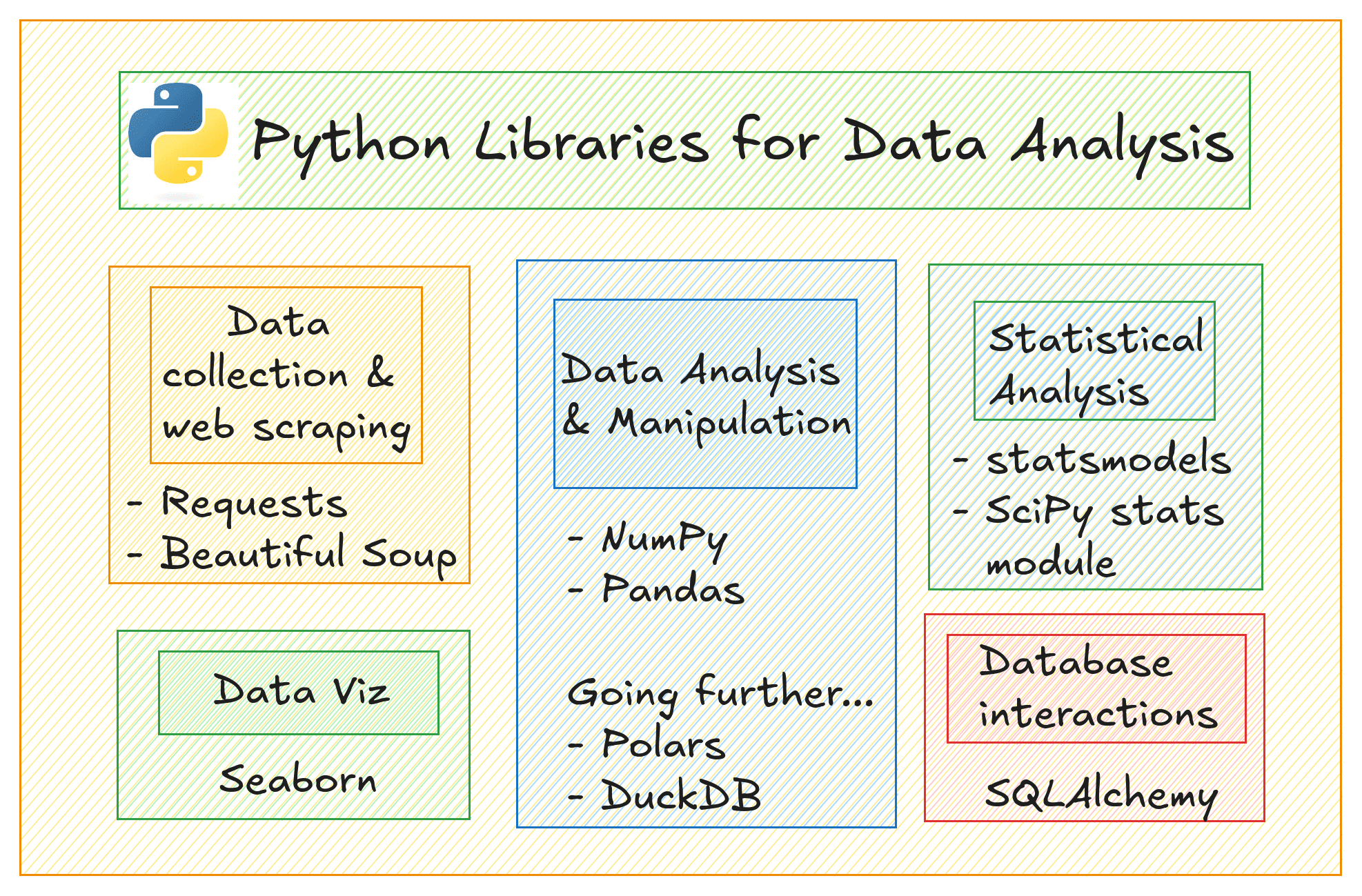10 Python Libraries Every Data Analyst Should Know
Interested in data analytics? Here's a list of Python libraries you cannot do without.

Image by Author | Created on Canva
Landing a data analyst role is a great way to start your data career. To work as a data analyst, you should be skilled in Python, SQL, BI tools, statistics, and more.
Beyond basic Python programming, the tasks that you’ll do as a data analyst will require you to become familiar with a few Python libraries. These libraries will simplify common tasks—from collecting, cleaning, analyzing, and visualizing data.
In this article, we'll go over Python libraries you should know as a data analyst. Let’s begin.

Python Data Analysis Libraries | Image by Author
1. Requests
What it’s for: Requests is a Python library you can use for HTTP requests to retrieve data from web APIs and websites. This is a must-have skill for data analysts to work with real-time data or fetching large external datasets.
Key Features
- Simple syntax for HTTP requests
- Handles authentication, headers, and error handling
- Simple parsing of JSON for quick data extraction
Learning Resources
2. Beautiful Soup
What it’s for: You’ll use Beautiful Soup for HTML and XML parsing to scrape web data—ideal for sourcing non-API data from websites.
Key Features
- Easy to navigate and extract elements from HTML and XML
- Use in conjunction with Requests for web scraping pipelines
Learning Resources
3. NumPy
What it’s for: NumPy is the foundational Python library for numerical computing and efficient array manipulations. It’s often helpful to work with NumPy before proceeding to use pandas and other libraries.
Key Features
- Fast multidimensional arrays and functions for mathematical operations
- Must know for data manipulation in Python (often used under the hood in other libraries like pandas and SciPy)
Learning Resources
4. Pandas
What it’s for: Pandas is a must-know Python library for data manipulation and analysis. You can use pandas for (almost) all data analysis projects—from data cleaning to exploration and transformation.
Key Features
- Dataframes for handling structured data
- Flexible indexing, merging, and aggregation functions
- Work with databases, CSV, JSON, and Excel files
Learning Resources
5. Polars
What it’s for: Once you know how to work with pandas, you can try using Polars. Polars facilitates ast data manipulation with an emphasis on performance, making it a great alternative to pandas for larger datasets.
Key Features
- Optimized for performance
- Supports out-of-core processing
- Query optimizer to find the most optimal way to run queries
Learning Resources
6. DuckDB
What it’s for: DuckDB is an in-process SQL OLAP database that works well with Python for analytics. Which makes DuckDB suitable for exploring and analyzing large datasets.
Key Features
- SQL-like syntax for querying CSV and Parquet files
- Supports complex analytical queries
Learning Resources
7. Statsmodels
What it’s for: The statsmodels Python library lets you work with statistical models and tests. You can use it for hypothesis testing and model diagnostics.
Key Features
- Comprehensive set of statistical tests and model-building tools
- Support for regression models and time series analysis
- Integrates with pandas for easier data handling
Learning Resources
8. SciPy (Stats Module)
What it’s for: You can also use SciPy for mathematical and statistical functions. You’ll often use it with NumPy for complex statistical calculations.
Key Features
- Support for linear algebra, optimization, and statistical functions
- Supports hypothesis testing, correlation calculations, and more
Learning Resources
9. Seaborn
What it’s for: Seaborn is a Python library for statistical data visualization, which builds on top of Matplotlib to simplify complex visualizations.
Key Features
- High-level functions for most common plots
- Simpler to learn and use than matplotlib
Learning Resources
10. SQLAlchemy
What it’s for: SQLAlchemy is a Python library for interacting with relational databases, providing flexibility to connect with multiple databases such as PostgreSQL, MySQL, and SQLite. It’s a valuable tool for data analysts, enabling seamless integration with databases for large datasets and more scalable, organized data manipulation.
Key Features
- Support for PostgreSQL, MySQL, SQLite, and more
- ORM (Object-Relational Mapping) for interacting with databases in Pythonic syntax
- Supports raw SQL queries alongside ORM for flexibility
Learning Resources
Wrapping Up
I hope you found this article helpful.
This should give you an idea of the tasks you’ll work on as a data analyst and the Python libraries that’ll help you do those tasks. To learn more check out the learning resources listed.
Happy data analysis!
Bala Priya C is a developer and technical writer from India. She likes working at the intersection of math, programming, data science, and content creation. Her areas of interest and expertise include DevOps, data science, and natural language processing. She enjoys reading, writing, coding, and coffee! Currently, she's working on learning and sharing her knowledge with the developer community by authoring tutorials, how-to guides, opinion pieces, and more. Bala also creates engaging resource overviews and coding tutorials.
